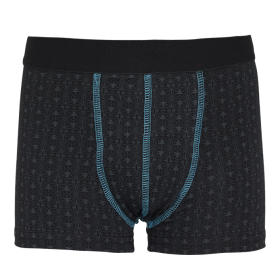An alarm is one of the most effective treatments for nocturnal enuresis.It works by waking the child as soon as the first drops of urine are present , which allows the brain to gradually learn to recognize the signal of a full bladder during sleep.

Urinary incontinence in children
The causes of nighttime incontinence
After age 5, bedwetting, often called enuresis, is more common in boys . Experts don't know what causes bedwetting. Children who experience it tend to be otherwise physically and emotionally normal. Most cases likely result from a combination of factors, including slower physical development, overproduction of urine during the night, difficulty recognizing bladder fullness during sleep, and, in some cases, anxiety. Many have a strong family history of enuresis, suggesting a hereditary factor.
Slower physical development
In children aged between 5 and 10, incontinence can be the result of:
- of a small capacity bladder
- long periods of sleep
- and the underdevelopment of the body's alarm signals that indicate a full and empty bladder.
Excessive urine production during sleep
Normally, the body produces a hormone that can slow down urine production. This hormone is called antidiuretic hormone, or ADH. The body normally produces more ADH during sleep so that the urge to urinate is lower. If the body doesn't produce enough ADH during the night, urine production cannot be slowed down, leading to the bladder overflowing. If a child hasn't yet learned the signals that their bladder is full, they will wet the bed.
Anxiety
Experts suggest that anxiety triggered by life events in children between the ages of 2 and 4 could lead to incontinence before they achieve full bladder control. Anxiety experienced after age 4 could lead to bedwetting even after a child has been dry for 6 months or more. These events include:
- Arguments between parents,
- Complicated social situations
- and major family events, such as the birth of a brother or sister.
Incontinence itself is an anxiety-provoking event. Strong bladder contractions can lead to leaks during the day, causing embarrassment and worry.
Genetics
Certain inherited genes appear to contribute to incontinence. In 1995, Danish researchers announced they had found a marker on human chromosome 13 that is responsible, at least in part, for bedwetting. If both parents were enuretic, a child has an 80% chance of also being enuretic. Experts believe that other, as yet unidentified, genes may also be involved in incontinence.
Obstructive sleep apnea
Bedwetting can be a sign of another condition called obstructive sleep apnea, in which a child's breathing is interrupted during sleep, often due to inflammation of the tonsils or adenoids. Other symptoms of this condition include snoring, mouth breathing, sinus infections, and sore throats. In some cases, successfully treating these breathing problems can also resolve the associated bedwetting.
Structural problems
Finally, a small number of incontinence cases are caused by physical problems in the urinary system in children. One condition, known as urinary reflux or vesicoureteral reflux, occurs when urine flows back up one or both ureters and can cause urinary tract infections and incontinence. Nerve damage associated with the congenital anomaly of spina bifida can also cause incontinence. In these cases, incontinence may manifest as a constant leakage of urine.
The causes of daytime incontinence
Daytime incontinence not associated with a urinary tract infection or anatomical abnormalities is less common than nighttime incontinence and tends to resolve sooner. One possible cause of daytime incontinence is an overactive bladder. Many children have abnormal daytime incontinence, with more frequent urination being infrequent. This form of incontinence occurs more often in girls than in boys.
Overactive bladder
The muscles surrounding the urethra (the tube that carries urine from the bladder) are responsible for keeping the passage closed, preventing urine from leaking out of the body. If the bladder contracts suddenly and forcefully, the muscles surrounding the urethra may not be able to retain the urine. This often occurs as a consequence of a urinary tract infection and is more common in girls.
Withdrawal of urine
Withholding urine refers to a child's deliberate act of not urinating for extended periods. For example, a child might not want to use the toilet at school or interrupt enjoyable activities, so they ignore the body's signal of a full bladder. In these cases, the bladder can overflow and cause urine leakage. Furthermore, these children often develop urinary tract infections (UTIs), leading to an overactive or irritable bladder.
Other causes
Some of the factors that contribute to nighttime incontinence can work together with frequent urination to produce daytime incontinence. These factors include a small bladder capacity, constipation, and the consumption of foods containing caffeine, chocolate, or artificial colors.
Treatment
Growth and development
Urinary incontinence sometimes resolves on its own. Here are some examples of what can happen over time:
- Increases bladder capacity.
- Activation of alarm signals by the body in a natural way
- An overactive bladder develops.
- DHA production becomes normal.
- The child learns to respond to the body's signals when it is time to urinate.
- Stop stressful events
- Many children outgrow incontinence naturally (without treatment) as they get older. The number of incontinence cases decreases by 15% each year after the age of 5.
Medications
Bedwetting can be treated by increasing ADH levels. The hormone can be stimulated with a synthetic version called desmopressin or DDAVP , which has recently become available in pill form. Patients can also use a desmopressin nasal spray. Desmopressin is approved for use in children. Another medication, called imipramine, is also used to treat bedwetting. It acts on the brain and the bladder. Unfortunately, drug treatment for bedwetting is not very effective, with most patients relapsing as soon as treatment is stopped.
Bladder training and related strategies
Bladder training involves exercises to strengthen and coordinate the muscles of the bladder and urethra, and can help with bladder control. These techniques teach the child to anticipate the urge to urinate and to avoid urinating when away from a toilet. Techniques that can help with bedwetting include:
- Determination of bladder capacity
- Extending from the bladder (delaying urination)
- Drink less liquid before sleeping
- Developing routines to wake up Unfortunately, none of these answers have proven effective.
Techniques that can help with daytime incontinence include:
- Urinating on a calendar, like every 2 hours (this is called timed urination)
- Avoid foods containing caffeine or other beverages (carbonated drinks) that can contribute to a child's incontinence.
- Going to the toilet frequently during the day













Latest comments